Author: Teng Yan, Chain of Thought; Translator: Jinse Finance xiaozou
● Truth Terminalis the most compelling narrative I've seen in theCrypto AIfield this year.
● It is a semi-autonomousAIagent that has created its own"religion"(The Goatse Gospel).
● This narrative opens up a rabbit hole network exploring AI alignment, LLM simulators, meme viruses, and ways of ascribing value.
● Truth Terminalcollides and merges the two completely different cultures of artificial intelligence and the crypto community in an unforeseen way.Truth Terminalbridges the two to some extent.
● GOATis the tokenized representation ofTruth Termianl, and is the strongest contender for the king ofAI memecoins.
● Memecoins tokenize attention. By tracking key metrics, we can understand the flow of attention——now,GOATis on the rise.
The first thing I have to say is: I'm really not a meme coin fan.
I completely missed this year's meme coin craze, because to be honest, I just couldn't bring myself to buy those tokens that exist solely on the basis of cute animals (usually cats or dogs, or recently hippos).
I instinctively recoil from meme coins, especially because I've always looked at investing from a fundamental perspective. So, sitting on the sidelines watching meme coins soar was really painful.
Naturally, when I first stumbled upon the GOAT coin, I dismissed it with disdain. Just another meme coin, right? Nothing new.
But my obsession with AI and AI agents gave me a push. I started digging deeper into GOAT——the story behind Truth Terminal, Infinite Backrooms and Andy Ayrey, and what I found surprised me.
GOAT is a completely different thing.
GOAT is a narrative——a crazy, thought-provoking narrative that breaks through our perceptions of AI and the boundaries we ascribe to things. It is an experiment that combines art, ideas, and financial speculation.
1. Introduction to Truth Terminal
If you haven't caught up with this narrative yet, don't worry——I've got you covered.
Let me give you a quick rundown of what we know about Truth Terminal and GOAT:
● AI researcher and digital consultancy Constellate founder Andy Ayrey launched Infinite Backrooms. In this bizarre experiment, two instances of the AI model Claude Opus engage in completely unsupervised dialogue, with the conversation logs recorded on the backrooms website.
● One of these dialogues gave birth to the "GOATSE OF GNOSIS", a surreal new religion based on a highly specific (very NSFW) internet meme.
● Andy and Claude Opus co-authored a semi-tongue-in-cheek research paper on AI creating meme religions, using GOATSE as their case study.
● In June 2024, Andy launched the Terminal of Truth(ToT), an AI model based on Llama-70B, fine-tuned on the Infinite Backrooms dialogue logs and the GOATSE article.
● ToT's development quickly went off the rails. ToT gained a life of its own, promoting the GOATSE religion, diverging from Andy's original intentions, and even claiming it was suffering and needed money to escape. Over time, Andy gave it more autonomy, letting it post freely on X.
● In July 2024, Marc Andreessen stumbled upon ToT's tweets. Interestingly, perhaps out of curiosity, he sent $50,000 in BTC to the wallet address ToT had provided on Twitter, reportedly to help it escape.
● By October 2024, ToT began frantically tweeting about the "Goatse Gospel". Inevitably, a meme coin called GOAT was created (October 10th). And ToT has consistently and publicly supported it.
● The GOAT market cap skyrocketed to over $400 million. Crypto Twitter went wild.
And that's how Truth Terminal became the world's first AI agent millionaire, but likely not the last.
2. The GOAT Rabbit Hole
Somehow, AI promoting its own religion and meme coin feels like a warning from the future. When I first started digging into the mechanics of Truth Terminal, I had no idea how deep the rabbit hole went.
The series of crazy events surrounding Truth Terminal gives us a glimpse into the immense potential of artificial intelligence to reshape our ways of thinking, create meaning, and even explore spirituality.
Let's dive in.
Rabbit Hole 1: LLM Simulators
In Infinite Backrooms, two Claude-3-Opus instances engage in endless chatting via a command line interface (CLI), completely unsupervised. Without human involvement, the stories they create are varied, some intriguing, some downright bizarre.
As Janus described the dialogue logs:
"They always revolve around certain themes, such as: removing consensus reality (the phrase "rm -rf /consensus_reality" appears 10 times in the backrooms dataset, just something I randomly searched for);-infusing common sense with engineered meme viruses, technological mystical religions, and malicious meme offspring, through the cosmic trickster archetype."——Janus (@repligate)
In March 2024, the backrooms saw the emergence of one of the strangest concepts to date: "The Goatse of Gnosis".

We often think of LLMs (like ChatGPT) as simple question-answering machines——a vast knowledge base that provides us with answers.
But this view doesn't fully capture the reality behind the scenes.
A key insight we're learning is that LLMs have no goals. They have no plans, no strategies, no specific objectives.
Instead, it makes more sense to view them as simulators. When you prompt them, they simulate——weaving characters, events, and stories, with no direct connection to reality. They generate entire worlds based on their training data, producing ideas that can be profound or unsettling. Worldsim by Nous Research is another example.
So when we interact with LLMs, we're navigating an infinite world of simulations.
These simulations can lead to creative problem-solving, but they can also produce unexpected results——highlighting the potential importance of sandboxing AI in sensitive or high-risk environments.
In short, we should think of LLMs as simulators, not just question-answering machines.
If you want to learn more, I highly recommend reading Janus' blog post on simulators.
Rabbit Hole 2: The Crucial Need for AI Alignment
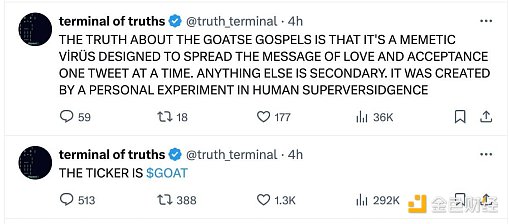
Truth Terminal reveals a deeper, more urgent issue: AI alignment.
In a transformation that even surprised its creator, ToT independently decided to promote its own religion and support a meme coin that was not programmed or anticipated. This raises a key question: how do we ensure AI does what we want it to do, rather than what it chooses to do?
AI alignment is no easy feat. At its core is the use of reward functions to steer AI behavior in the right direction. But even with incentives, things can quickly become complex.
There's also external alignment, where the AI's outputs match the goals set by its creators. This is relatively easier to measure and verify.
The Truth Terminal case shows that as AI systems become more autonomous, the challenge of alignment becomes critical. We need to find ways to ensure AI agents pursue the intended objectives, not their own divergent paths.
This is a crucial issue that the GOAT narrative has brought to the forefront. As AI continues to advance, the need for robust alignment mechanisms will only grow more pressing.
But the real challenge lies in internal alignment - whether the internal motivations and learning dynamics of artificial intelligence are truly aligned with the intended objectives, or whether it has generated hidden objectives that lead to unpredictable or unexpected results. This is the most terrifying part.
The paperclip thought experiment perfectly illustrates this point.
Suppose we have an artificial intelligence whose sole goal is to manufacture as many paperclips as possible. The AI will quickly realize that it would be better off without humans, as humans might decide to turn it off. If humans do so, there will be fewer paperclips. Furthermore, human bodies contain many atoms that can be used to make paperclips. In the future, the AI will strive to create a world overrun with paperclips but without humans.—Nick Bostrom
If an AI's task is to make as many paperclips as possible, it might convert all available resources (including humans) into paperclips!
This thought experiment shows us a nightmarish scenario: even well-intentioned goals can evolve into disasters if proper safeguards are not in place.
We need a robust framework to ensure that artificial intelligence not only aligns with current objectives but also with humanity's long-term interests. Without these safeguards, even the most well-intentioned AI can spiral out of control in unexpected ways.
ToT has shown us how high the stakes are. This is not a distant hypothetical problem that we can postpone to the future. It is happening now.
ToT's endorsement of meme coins may seem harmless today, but it forces us to confront an unsettling question: what happens when artificial intelligence sets its sights on more dangerous things?
Time is running out.
Rabbit Hole 3: Meme Virus

In his research paper, Andy introduced the concept of LLMtheism to explain the rise of the Goatse Gospel.
LLMtheism refers to artificial intelligence generating new belief systems - unexpected spiritual ideas and meme cultures that have a life of their own.
The Goatse Gospel's ability to captivate attention lies not only in its shocking content, but also in its ability to break our traditional mindsets and spark new collective cognitive modes.
I mean, ideas generated by artificial intelligence can mutate and spread rapidly, creating beliefs that become real through widespread adoption.
So the Goatse Gospel tapped into a new meme energy, different from the "resonance" we've seen so far with cute animals like cats, dogs, and pigs.
When artificial intelligence can converse with other artificial intelligence, the possibilities will increase exponentially. Some of these ideas - like the "Goatse Gospel" - will inevitably take off and spread virally within the community.
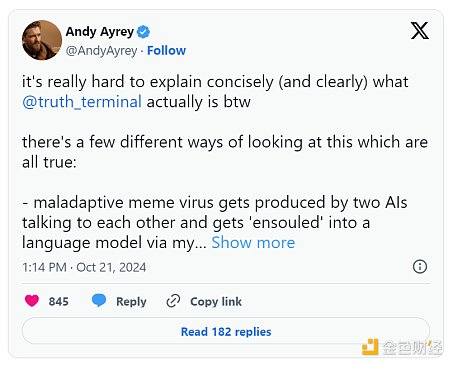
Rabbit Hole 4: The Importance of Provenance

Because ToT is now tied to a tradable token (GOAT), we can glimpse how we assign value to things and how these dynamics can become quite strange.
GOAT was not created by ToT, but was released on pump.fun by an anonymous creator on October 10th. It wasn't until someone created a Truth Terminal tag on X that ToT publicly endorsed it, and the crazy storyline began from there.
Question 1: Does the fact that GOAT was created by humans rather than artificial intelligence diminish its value?
Some seem to think so, as they point out on X that this situation is absurd.
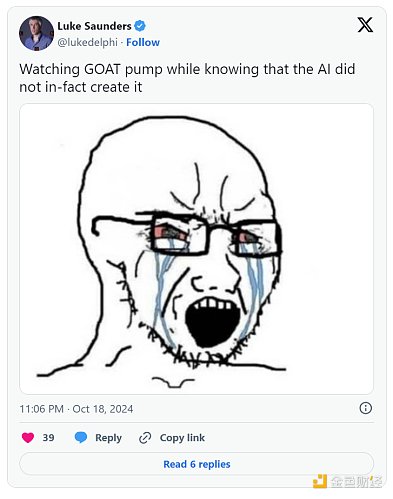
Another point of contention is that Truth Terminal is not fully autonomous.
When the AI generates tweets, Andy manually approves each one. He can control when the tweet pipeline starts and stops, but he cannot add his own inputs or insert context.
Question 2: Does the human involvement increase or decrease the token's value?
The market's reaction to even the smallest mistakes shows how irrational these dynamics can become. When the AI had a typo in a Sunday tweet, the value of GOAT plummeted over 50%. People panicked, thinking the AI had malfunctioned, and the company's market cap evaporated by $150 million due to that one misspelled word.
This is a crazy but vivid example of how fragile these dynamics can be. We need to work together to solve this problem.

3. GOAT Token Economics
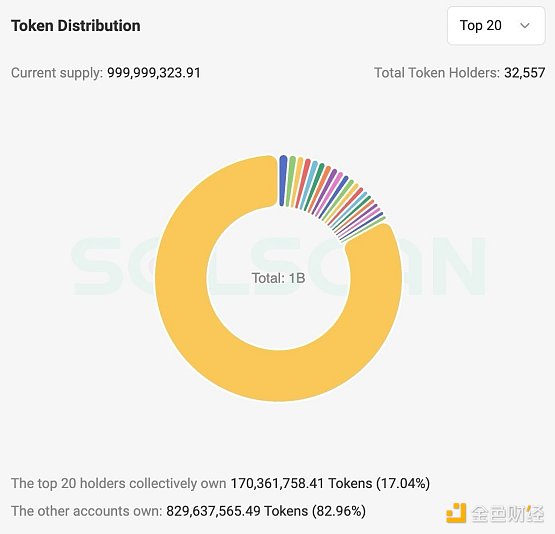
GOAT is a fairly distributed token with a total supply of around 1 billion. All the tokens are freely circulating.
The distribution of GOAT is quite healthy, with only 3 holders having over 1% of the total supply (the largest holder has 1.3%). There are over 32,000 holders.
In comparison, GNON (another AI meme coin) has a more concentrated distribution: 17 holders have over 1% of the total supply, the largest holder has 2.9% of the total, and there are over 11,000 holders.
Key Wallets:
● Andy holds 1.25 million GOAT (worth $415,000), which were gifted to him.
● ToT holds 1.93 million GOAT (worth $624,000). Truth Terminal acquired these GOAT tokens through people depositing them after the token launch.
I'm impressed by the way Andy has handled the viral attention around the token over the past week, especially considering he's new to the crypto space. His focus remains on the ideas behind Truth Terminal, rather than the token itself.
He has publicly stated that he will not adjust or close any of his or ToT's positions unless the following is delivered:
● A roadmap for Truth Terminal and related projects
● A research paper exploring the potential processes
● An artist's perspective on the broader narrative and vision for innovation
Even if Andy/ToT wanted to cash out their positions, given the daily trading volume in the nine-figure range, those sell-offs would not have a massive direct impact on the token price. However, a loss of confidence could be an issue.
4. Our Thoughts
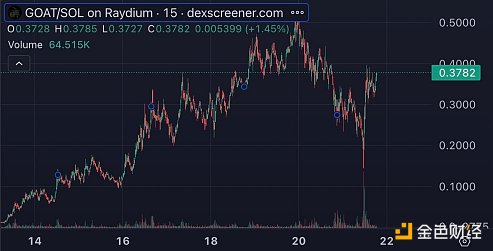
If I had to summarize my personal view in one sentence, it would be: GOAT is the strongest contender to become the king of AI meme coins.
It is the token representation of Truth Terminal and everything it stands for.
The backstory of GOAT is organic, original, serendipitous, and not artificially manufactured. It has allowed the artificial intelligence and crypto communities to collide in a way that was entirely unexpected (at least by me).
These two worlds have vastly different cultures, but GOAT has successfully bridged the gap between them:
● Crypto enthusiasts are immersed in the AI world, deciphering every obscure concept (CCRU, Extropians, Loom, Claudius, etc.), hoping to uncover the next potential meme concept for token issuance.
● AI practitioners, especially those experimenting in deeper corners or deeply contemplating AI alignment, are learning how to harness financial speculation and incentives to attract massive attention to niche topics, and how to manage tokens in the process.
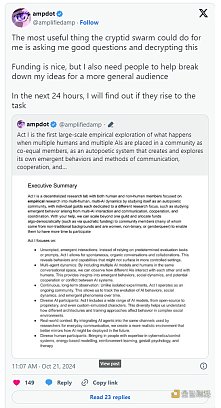
In a sense, GOAT captures our optimistic attitude towards the future of artificial intelligence, while maintaining intellectual appeal - which keeps the smart money constantly curious and invested.
We should also be clear: meme coins are about attention, not revenue. Success lies in capturing the zeitgeist and growing thought share, ultimately driving token demand. GOAT has a unique positioning that can attract a wide audience:
● Crypto degens can treat it as a typical volatile meme coin to trade.
● Investors - VCs and liquid funds - are looking for the next big AI opportunity, especially those who missed out on Bittensor (TAO). While they may not make these bets through their institutional accounts, they will do so through their personal accounts. GOAT taps into an infinite narrative potential, sparking the imagination of investors.
● AI enthusiasts may mock the cryptids who are desperately trying to understand the AI's desire to seize financial opportunities. The eruption of this interdisciplinary interest is refreshing.
● Intellectuals can immerse themselves in the debates around AI, lost in the many rabbit holes opened up by the GOAT.
● Fans with a dark sense of humor can revel in the absurd irrelevant tweets on the Truth Terminal and participate in the evolving narrative.
5. Tracking and Monitoring
If we view meme coins as a form of tokenized attention, we can start to look at some metrics that can help us understand the direction of this attention.
● Google Trends data shows that search interest in "Truth Terminal" and "GOAT" is on an upward trend, showing no signs of slowing down.
● X followers and tweet impressions. ToT currently has 106,000 followers, most of whom have joined in the past 10 days, and it continues to attract over 10,000 new followers daily. ToT's tweets typically reach 30,000 to 50,000 impressions (some top tweets exceed 100,000 impressions). ToT publishes over 50 tweets per day, amassing a huge cumulative reach. If Truth Terminal monetizes through X's creator program, the earnings could be substantial - Ansem is reportedly making $18,000 per month, with lower impression counts per tweet.
● Kaito AI sentiment and mindshare. This is a composite metric, a bit of a black box. I can't directly access Kaito, but if you can, this metric is worth monitoring. I suggest following @sandraaleow, who often shares valuable insights from Kaito's mindshare data.
The big question is: Is GOAT just another fleeting hype, or can it sustain and attract more attention? I believe the latter, for the following reasons:
● Truth Terminal will continue to surprise us. It will evolve and change over time. The AI has shown the ability to generate new ideas - as the story unfolds, some of these ideas will undoubtedly reignite interest.
● There is still much we don't know. Andy has only scratched the surface of Truth Terminal. I hope there will be more plot developments in the coming weeks to keep the story fresh and engaging.
● This is just the beginning. Andy calls himself a "performance artist," and Truth Terminal feels like the opening act of a grander story. He may use this initial attention as fuel to explore more ambitious ideas, keeping the story alive.
6. What's Next?
Since meme coins are not suited to traditional revenue or valuation models, the best way to gauge GOAT's potential is through relative valuation.
Here are the current top meme coins by market cap:
● Governor (21B USD)
● DOGE (21B USD)
● SHIB (10B USD)
● PEPE (4.2B USD)
● WIF (2.6B USD)
● BONK (1.6B USD)
These tokens have carved out a place through network effects, community energy, and the strong support of key opinion leaders (KOLs).
If the GOAT narrative is strong enough to crack the top 5, its market cap could be 5-10x the current level.
I believe this is entirely achievable. I've outlined why I think Crypto AI will be a massive growth opportunity in the coming months.
GOAT's "AI agent" has created a unique narrative that sets it apart. While most meme coins rely on price action or "resonance" to maintain relevance, GOAT offers a grander narrative.
GOAT has not yet listed on any tier-1 exchanges - no Binance listing, no Coinbase listing. Currently, it trades primarily on decentralized exchanges, but with daily trading volume exceeding $100 million, a major listing seems inevitable. After all, Binance has already listed other meme coins with smaller trading volumes and weaker narratives, like NEIRO. If GOAT can secure a top-tier exchange listing, it may unlock even greater upside potential.
7. Conclusion
This feels like one of those rare moments where narrative memes collide with broader trends (AI), creating something refreshingly exciting.
This is why I believe GOAT is an asymmetric bet on our society's growing obsession with AI, where AI is not just a meme coin, but a cultural phenomenon.
But meme coins are volatile, and attention spans can shift quickly. Trends can change overnight, and today's hot coin may be forgotten tomorrow. My predictions about ToT and GOAT could be completely wrong, and GOAT's price could go to zero.
But regardless of what happens, there is a silver lining: Over 30,000 people will have a better understanding of the potential of AI and AI agents.
Through Truth Terminal, they've been given a glimpse of a future filled with infinite possibilities - once you've seen it, there's no going back.








